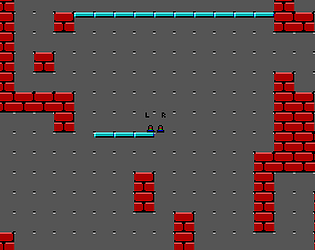[NOTE: This was run from the EXE, and compared against DOSBox-X behaviour. The lives indicator was missing in both cases, which may suggest that the EXE is an older build.]
Nice to find a game that actually runs too *fast* on my Covington! (Well, OK, one can still get used to it...) You may need to look through how you're doing your delays.
Also there's something funky with the keyboard handling on real hardware where for some reason I end up accelerating indefinitely if I use the up arrow key, but playing using the numpad is fine. Not sure how it would get the escape but not the break code somehow...
One more thing: A real screen tends to take a while to switch modes - mine does it in about 1 second. A "Press any key to begin" / "Press any key to exit" would help massively here. Or in the latter case, switching to SCREEN 0 would be better, as the text will stay around when the program closes.
Anyway, this game was fun. I do wonder what it would take to do a CGA version of this...


